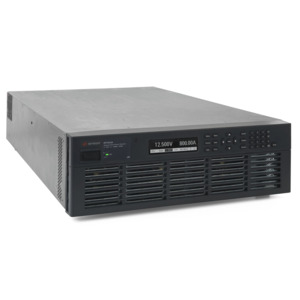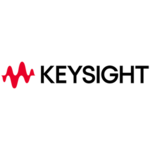
- Description
- Specifications
- Documents
Keysight RP7933A Bidirectional/Regenerative Power System
Features and Specifications
- Max Voltage Per Output: 20 V
- Max Current per Output: +/-800 A
- Max Power: 10 kW
- Number of Outputs: 1
- Type: ATE / 3U
- AC Input Voltage: 200/208 VAC
- Operate in a two-quadrant mode as a power source and regenerative electronic load
- Fast output speed and sub-millisecond command processing time
- Regeneration returns 90% of power to the grid, reducing cooling costs
- Connectivity includes LAN (LXI Core), USB, and GPIB
- Ideal for testing energy storage and converters
Options
- PathWave BenchVue Advanced Battery Test And Emulation Software: Unique battery modeling enables you to determine your device's power consumption, emulate an actual battery, and import existing battery models. Test and emulate batteries up to 200 kW and up to 2 kV.
Continuously Source and Sink Current With The RP7933A
The RP7933A is a 20 V, 800 A, 10 kW, 200/208 VAC, Bidirectional/Regenerative Power Supply that has a two-quadrant, bidirectional sourcing and sinking capability, which allows for seamless, uninterrupted transitions between sourcing and sinking current without changing the power supply's output characteristics or introducing any disruptive behavior. Unlike traditional power supplies with rectangular output characteristics, the RP7933A has an autoranging output characteristic that expands the power curve, providing more voltage and current combinations in one power supply.
The RP7933A also has a battery emulation feature that allows you to test your devices under the same power conditions that exist in actual use. This is important when characterizing battery operating life and detecting early product failures. The RP7900 DC sources simulate the effects of internal resistance of the battery, enabling them to emulate the operation of batteries in different charge states. You can use the bidirectional RP7933A as a power source or an electronic load, just like a battery.
RP7900 Series Overview
High power applications, such as hybrid and electric vehicles that use over 300 V batteries instead of 12 V ones, require more advanced test equipment than low power ones. Testing at high power involves different issues that are not important at low power, such as site preparation, safety, and cooling. These applications are found in various sectors, such as aerospace defense, infrastructure, automotive and energy. A ready-made solution that has a low ownership cost can help reduce the expenses of high power testing by using less space, producing less heat, and ensuring reliability.
The RP7900 Series from Keysight is a solution that meets this challenge. It is a regenerative power system that can supply and absorb DC power up to 2000 V, up to +/- 800 A and up to 30 kW. It works in two-quadrant mode, acting as both a power source and a regenerative electronic load. It also has built-in safety features that protect the user and the device under test. The regenerative feature allows the energy that is usually wasted to be fed back to the grid cleanly, saving money on energy and cooling. Moreover, by integrating the source and load functions into a small 3U-high and 5U-high package, it saves energy, space, and time. The RP7900 Series is the fastest, most precise, and most integrated regenerative power system available.
Characterize A DUT's Power Profile With Advanced Measurements
The RP7900 provides simultaneous voltage and current measurement capabilities that deliver high accuracy and resolution. Make measurements using two main modes: averaged or digitized. In average mode, the RP7900 delivers high-accuracy voltage and current measurements. The digitizing capability allows you to capture dynamic current or voltage profiles.
In addition to high-accuracy voltage and current measurement capabilities, the RP7900 Series regenerative power system offers built-in power, peak power, amp-hour, and watt-hour calculations. These measurements help simplify your power efficiency and storage calculations.
Generate Voltage And Current Transients
DUTs that are operated in rugged environments, such as automotive electronics and avionics, can often experience transient behavior from the power source, such as voltage dropouts or surges. To ensure your DUT can stand up to these real-world transients, you must simulate worst-case power transient conditions in the test process. The RP7900 provide three different functionalities for simulating either voltage or current transients for testing:
Step: One-time event that steps the output voltage or current up or down in response to a triggered event.
Constant dwell arbitrary waveforms: An arbitrary waveform generator (ARB) allows you to generate complex user-defined voltage or current waveforms of up to 65,535 data points. One dwell setting applies for the entire ARB, from 10.24 µs to 0.30 seconds.
List: A list can consist of up to 512 steps. Each step in the list can have a unique dwell time associated with it, which specifies the time in seconds that the list will remain at that step before moving on to the next step. Lists can also be trigger-paced, in which case the list advances one step for each trigger received. List is not supported in primary/secondary mode on the 5 kW and 10 kW RP7931A - RP7963A (but is supported on the 20 kW and 30 kW RP7972A - RP7984A).
Simplify System Connection
The RP7900 Series power supplies come standard with GPIB, Ethernet/LAN, USB 2.0 giving you the flexibility to use your I/O interface of choice today and safeguard your test setup for the future. There is no need to worry whether you are choosing the right interface when they all come standard. The RP7900 is compliant to 1.5 LXI Device Specification 2016 and includes a built-in Web interface. This means you can control the RP7900 remotely using a Web browser and a LAN connection.
NOTE: Line Cords and Terminations
Due to the number of different line cords and terminations around the world, the RP7900 power supplies do not come with line cords or terminations. Users will need to supply their own dependent on the local laws and codes of the country/region where the power supply will be used.
